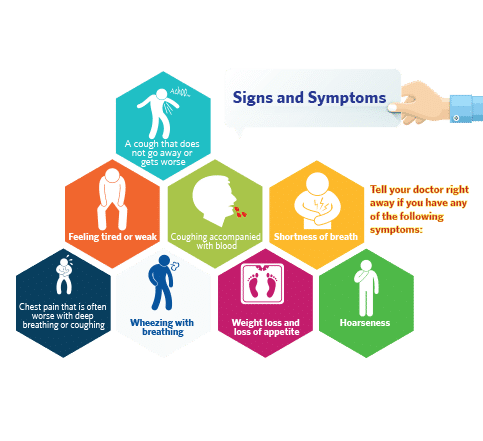Lung Cancer
Lung cancer is uncontrolled growth of abnormal cells in one or both of the lungs.
1. Smoking
- At least 80% of all lung cancer deaths are thought to result from smoking.
- The risk for lung cancer among smokers is higher than non-smokers.
- The longer you smoke and the more packs per day you smoke, the greater your risk.
- Secondhand smoke increases your risk of developing lung cancer by almost 30%.
2. Certain occupations are associated with an elevated risk of developing lung cancer, such as:
- Asbestos workers (Asbestos: a group of naturally occurring fibrous minerals has many industrial uses).
- Wood workers
- Painters
- Printing presses workers.
- Uranium mining
3. Working in places where smoking is allowed like restaurants and coffee shops.
4. Air pollution especially near heavily trafficked roads.
5. Personal or family history of lung cancer.
Tell your doctor right away if you have any of the following symptoms:
- A cough that does not go away or gets worse
- Chest pain that is often worse with deep breathing or coughing.
- Hoarseness.
- Weight loss and loss of appetite.
- Coughing accompanied with blood.
- Shortness of breath.
- Feeling tired or weak.
- Wheezing with breathing.

You can reduce your risk of developing lung cancer by:
- Stop smoking.
- Avoid secondhand smoking: secondhand or passive smoking is the inhalation of smoke from burning tobacco products by nonsmokers.
- Be aware of workplace exposures and use the personal protective equipment.
- Be Careful and Aware at Home: some chemicals that contribute to lung cancer are found in your home, like the cleaning chemicals products and the Wood smoke from wood burning stoves; so carefully read labels on cleaning products and follow the instructions for safe usage, try to open the window while using them and wear a protective mask if needed.
- Be physically active for at least 30 minutes per day (4- 5 times per week).
- Eat a variety of vegetables, fruits, whole grains and legumes, reduce the use of red meats and avoid processed food.
Ask your doctor about the suitable and available screening tests if you are:
- 55 years old and above.
- Smoker or have quit smoking within the last 15 years.
- Have at least a 30 packs/year smoking history.
- + Risk factors
-
1. Smoking
- At least 80% of all lung cancer deaths are thought to result from smoking.
- The risk for lung cancer among smokers is higher than non-smokers.
- The longer you smoke and the more packs per day you smoke, the greater your risk.
- Secondhand smoke increases your risk of developing lung cancer by almost 30%.
2. Certain occupations are associated with an elevated risk of developing lung cancer, such as:
- Asbestos workers (Asbestos: a group of naturally occurring fibrous minerals has many industrial uses).
- Wood workers
- Painters
- Printing presses workers.
- Uranium mining
3. Working in places where smoking is allowed like restaurants and coffee shops.
4. Air pollution especially near heavily trafficked roads.
5. Personal or family history of lung cancer.
- + Early signs and symptoms
-
Tell your doctor right away if you have any of the following symptoms:
- A cough that does not go away or gets worse
- Chest pain that is often worse with deep breathing or coughing.
- Hoarseness.
- Weight loss and loss of appetite.
- Coughing accompanied with blood.
- Shortness of breath.
- Feeling tired or weak.
- Wheezing with breathing.

Early signs and symptoms of Lung Cancer - + Prevention
-
You can reduce your risk of developing lung cancer by:
- Stop smoking.
- Avoid secondhand smoking: secondhand or passive smoking is the inhalation of smoke from burning tobacco products by nonsmokers.
- Be aware of workplace exposures and use the personal protective equipment.
- Be Careful and Aware at Home: some chemicals that contribute to lung cancer are found in your home, like the cleaning chemicals products and the Wood smoke from wood burning stoves; so carefully read labels on cleaning products and follow the instructions for safe usage, try to open the window while using them and wear a protective mask if needed.
- Be physically active for at least 30 minutes per day (4- 5 times per week).
- Eat a variety of vegetables, fruits, whole grains and legumes, reduce the use of red meats and avoid processed food.
- + Early detection
-
Ask your doctor about the suitable and available screening tests if you are:
- 55 years old and above.
- Smoker or have quit smoking within the last 15 years.
- Have at least a 30 packs/year smoking history.
